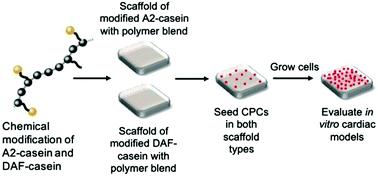当前位置:
X-MOL 学术
›
J. Mater. Chem. B
›
论文详情
Our official English website, www.x-mol.net, welcomes your feedback! (Note: you will need to create a separate account there.)
Biodegradable methacrylated casein for cardiac tissue engineering applications
Journal of Materials Chemistry B ( IF 7 ) Pub Date : 2021-1-18 , DOI: 10.1039/d0tb02496a Sonali Sudhir Sali 1, 2, 3, 4, 5 , Maree L. Gould 1, 2, 3, 4, 5 , Muhammad Qasim 1, 2, 3, 4, 5 , M. Azam Ali 1, 2, 3, 4, 5
Journal of Materials Chemistry B ( IF 7 ) Pub Date : 2021-1-18 , DOI: 10.1039/d0tb02496a Sonali Sudhir Sali 1, 2, 3, 4, 5 , Maree L. Gould 1, 2, 3, 4, 5 , Muhammad Qasim 1, 2, 3, 4, 5 , M. Azam Ali 1, 2, 3, 4, 5
Affiliation

|
Casein is a naturally derived amino group (–NH2) rich protein, that enables surface functionalization leading to hydrophilicity, which in turn facilitates better cell adhesion. Casein obtained from either commercial β-casein rich skim milk (A2 milk) or dissolved air flotation (DAF) technology was tested for its potential for tissue engineering applications in a comparative study. A novel biodegradable biomaterial was synthesized from casein by chemically modifying with methacrylic anhydride (MA) and combined with polyvinyl alcohol (PVA) and polyvinyl pyrrolidone (PVP) blend. The resulting methacrylated casein (CasMA) with the two polymers was processed into porous scaffolds with low and high MA concentrations to demonstrate CasMA's ease of modification and reproducibility. Fourier Transform Infrared Microscopy (FTIR) and Proton Nuclear Magnetic Resonance (1H NMR) revealed the presence of all the components and the successful modification of casein. The rheological and morphological analysis presented viscous behaviour and columnar hollow tube-like microstructures in agreement with the biomaterials’ swelling and biodegradation behaviour. The live/dead in vitro assay showed high cell viability that agreed with the cell proliferation (MTT) assay in vitro, which indicated increased proliferation upon casein modification at appropriate biomaterial concentrations and volumes. This study not only showed a possible mechanism of casein methacrylation but also presented the potential use of waste materials like DAF-casein as a value-added product for tissue engineering applications.
中文翻译:

用于心脏组织工程应用的可生物降解的甲基丙烯酸酪蛋白
酪蛋白是天然衍生的氨基(–NH 2)丰富的蛋白质,可实现表面功能化,从而带来亲水性,进而促进更好的细胞粘附。在一项比较研究中,测试了从富含β-酪蛋白的脱脂牛奶(A2牛奶)或溶解气浮(DAF)技术获得的酪蛋白在组织工程应用中的潜力。通过用甲基丙烯酸酐(MA)进行化学修饰,并与聚乙烯醇(PVA)和聚乙烯吡咯烷酮(PVP)共混物,由酪蛋白合成了一种新型的可生物降解的生物材料。将所得的带有两种聚合物的甲基丙烯酸酪蛋白(CasMA)加工成具有低和高MA浓度的多孔支架,以证明CasMA易于修饰和再现。傅里叶变换红外显微镜(FTIR)和质子核磁共振(11 H NMR显示所有组分的存在和酪蛋白的成功修饰。流变学和形态学分析显示出粘性行为和圆柱状空心管状微观结构,与生物材料的溶胀和生物降解行为一致。活/死体外试验显示出高细胞活力,与体外细胞增殖(MTT)试验相符,这表明在适当的生物材料浓度和体积下,酪蛋白修饰后,增殖增加。这项研究不仅表明了酪蛋白甲基丙烯酸酯化的可能机制,而且还提出了将DAF-酪蛋白等废料作为组织工程应用的增值产品的潜在用途。
更新日期:2021-01-25
中文翻译:

用于心脏组织工程应用的可生物降解的甲基丙烯酸酪蛋白
酪蛋白是天然衍生的氨基(–NH 2)丰富的蛋白质,可实现表面功能化,从而带来亲水性,进而促进更好的细胞粘附。在一项比较研究中,测试了从富含β-酪蛋白的脱脂牛奶(A2牛奶)或溶解气浮(DAF)技术获得的酪蛋白在组织工程应用中的潜力。通过用甲基丙烯酸酐(MA)进行化学修饰,并与聚乙烯醇(PVA)和聚乙烯吡咯烷酮(PVP)共混物,由酪蛋白合成了一种新型的可生物降解的生物材料。将所得的带有两种聚合物的甲基丙烯酸酪蛋白(CasMA)加工成具有低和高MA浓度的多孔支架,以证明CasMA易于修饰和再现。傅里叶变换红外显微镜(FTIR)和质子核磁共振(11 H NMR显示所有组分的存在和酪蛋白的成功修饰。流变学和形态学分析显示出粘性行为和圆柱状空心管状微观结构,与生物材料的溶胀和生物降解行为一致。活/死体外试验显示出高细胞活力,与体外细胞增殖(MTT)试验相符,这表明在适当的生物材料浓度和体积下,酪蛋白修饰后,增殖增加。这项研究不仅表明了酪蛋白甲基丙烯酸酯化的可能机制,而且还提出了将DAF-酪蛋白等废料作为组织工程应用的增值产品的潜在用途。


























 京公网安备 11010802027423号
京公网安备 11010802027423号